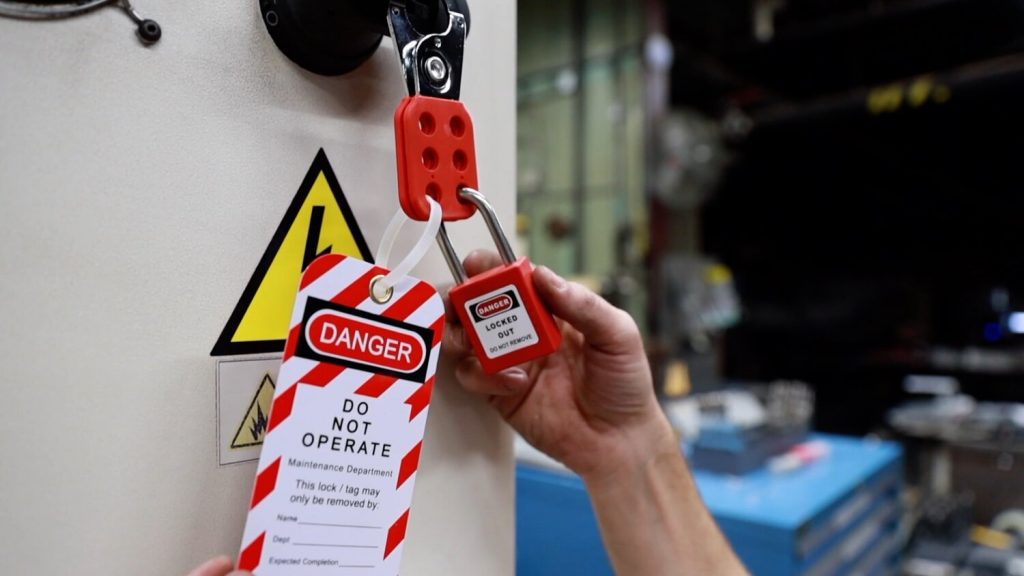In this week’s blog we will be focusing on safety and how Lockout Tagout (LOTO) are used in the workplace to ensure when workers are carrying out maintenance work, they are able to do safely without any risk of accident. We will also explore what the various colour codes represent and how they signal different hazards.
In case you haven’t heard of the term Lockout Tagout (LOTO), it is a safety system that prevents the unexpected start-up of machinery and equipment during maintenance and service procedures. A lockout device, typically a padlock is used to secure an energy isolating device and a tagout is a tag that warns employees when the equipment should not be used. The difference between a lock out and tag out device, the lock out stops employees from using the device and the tagout informs employees when it is unsafe to use it. Combined they provide two levels of protection. Lockout devices have a key or combination to avoid unintentional power start-ups. The tagout systems are used to alert users when machinery is out of order for maintenance.

Why are they used?
Lockout/Tagouts are used to ensure dangerous machinery does not experience a sudden energy burst that could cause accidents and injury to workers during maintenance periods. The machinery needs to ensure that no energy sources can be activated and turn on the machines.
What can be considered hazardous energy?
A power source that is not expected to be running during a maintenance check is considered a hazardous energy. If any of the following types of energy were to discharge, it could cause extremely dangerous situations to occur and compromise worker safety:
- Electrical
- Hydraulic
- Chemical
- Thermal
- Mechanical
- Thermal
- Radiation
The risk of not using these safety features could cause serious harm to workers including burns, electrocution, amputations, crushing injuries, fractures, paralysis, and lacerations, to mention a few. These accidents could be life-changing, so it is crucial to ensure the energy sources do not contain any remaining power. The LOTO standard establishes that it is the employer’s responsibility to protect workers from hazardous energy and ensure the correct training is provided to workers, so the correct safety controls are in place.
The Occupational Safety and Health Administration (OSHA) regulates procedures and practices, while there is no official colour coding system, there are different colour lockout locks and tags, to indicate why they are in use. The tags typically are made of a bright colour, to visually stand out and alert workers. The most common themes are as follows:
- Red to indicate danger.
- Yellow to indicate caution.
- Orange to indicate warning.
- Fluorescent orange or orange/red to indicate a biological hazard.
Red is the most used colour and typically includes the word ‘Danger’ in red lettering or with an outline to make it bold. While you can use any colour you prefer OSHA states that they must be durable, substantial, standardised, identifiable, and exclusively used for safety and controlling energy. Your workers need to be able to see the tag and understand exactly what is taking place to ensure optimum safety.
OSHA safety standards indicates procedures must be in the place to prevent the release of harmful energy and isolate all machinery.
‘General Industry 29 CFR 1910.147: This section states that employers must establish a plan and employ systems that protect workers when repairing machinery. This standard involves attaching suitable energy-isolating lockout and tagout devices to equipment, preventing stored energy from discharging suddenly.’
‘Construction 29 CFR 1926.417: This regulation states that workers must appropriately tag all deactivated controls during maintenance tasks to warn and inform others of the process.’
When should LOTO be used?
To conduct safe working practices, LOTO should be used when equipment requires cleaning, repair, or service, as well as when operators are required to get close to hazardous elements of the machinery and when a new part is being installed or replaced. It is advised to have a supervisor to perform an equipment inspection.
How to use LOTO?
According to OSHA an authorised employee must follow these procedures:
- All equipment should be inspected to ensure there is no visible damage, and the machine is in working order.
- The same employee should attach and remove the lockout and tagout devices from the equipment.
- Once the service has been completed the rest of the team are aware of its completion and clears the area.
LOTO can be used on equipment with built-in locking mechanism or if it has a hasp to attach a lockout device and can be locked without interfering in the energy control ability. The tagout devices don’t replace the need of using lockout tools so it is recommended to use both to increase worker safety. Make sure you prepare, inform workers when planned maintenance is taking place, ensure all machinery is shut down and all possible hazardous energy has been disconnected, install the lockout/tagout devices to ensure the service can be undertaken safely. A final check should take place to ensure it is completely safe to undertake the procedures.
We hope you enjoyed reading this week’s blog and learnt something new. We always want to know what our readers think, so be sure to leave a comment below. Feel free to suggest any topics you’d like to read about in future blogs and if you’d like to share this blog with others who may also enjoy reading it, please do, the links are below.

